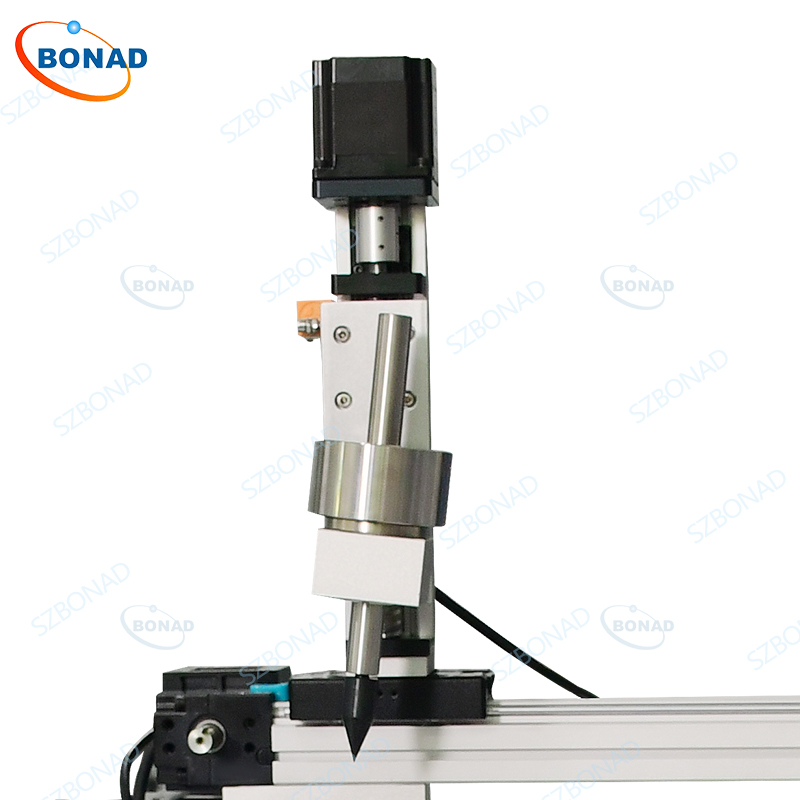IEC 60335-1 Clause 21.2 Scratched Surface Resistance Test Apparatus | Abrasion Resistance Tester
Model: BND-DH-21
Overview
Welcome to our product page for the IEC 60335-1 Clause 21.2 Scratched Surface Resistance Test Apparatus, also known as the Abrasion Resistance Tester. Our advanced testing equipment is designed to measure the abrasion strength of printed circuit boards and the insulating accessible parts of household appliances, ensuring compliance with international safety standards.
Compliance Standards
Our Abrasion Resistance Tester adheres to the following standards:
-
IEC 60335-1 Clause 21.2
-
IEC 60950 Clause 2.10.8.4
These standards ensure that the device provides accurate and reliable results in testing the durability and safety of insulation materials.
Technical Specifications of Abrasion Resistance tester:
Below are the detailed technical specifications of our Abrasion Resistance Tester:
|
Input power supply
|
AC 220 V/50Hz
|
|
Test station
|
One station
|
|
Control system
|
PLC + touch screen
|
|
Drive mode
|
Stepper motor drive
|
|
Scratching speed
|
0-25 mm/s adjustable, can be preset
|
|
Scratching times
|
0-9999 times, it can be preset
|
|
Scratching distance
|
Approximately 25 % of the length of the insulation, can be preset
|
|
Test bench
|
Can be 90° rotated
|
|
Scratching pressure
|
10N±0.5N
|
|
Scratching pin
|
hardened steel pin, the end of which has the form of a cone with an angle of 40° . Its tip is rounded with a radius of 0,25 mm ± 0,02 mm
|
|
Scratching angle
|
80° ~ 85° to the horizontal and loaded
|
Testing Procedure
The testing procedure for our Abrasion Resistance Tester is as follows:
1. The insulation is heated to the temperature measured during Clause 11 tests.
2. A hardened steel pin, shaped like a cone with a rounded tip (radius: 0.25 mm ±0.02 mm), is used to scratch the surface.
3. The pin is held at an angle between 80° and 85° to the horizontal and loaded with a force of 10N ±0.5N.
4. Two parallel scratches are made at a speed of approximately 20 mm/s, covering about 25% of the insulation length.
5. Two additional scratches are made at a right angle (90°) to the first pair without crossing them.
6. The test fingernail (Figure 7) is then applied with a force of approximately 10N to check for further damage.
7. The insulation should withstand this test without any additional damage or separation.
8. Finally, a hardened steel pin is applied perpendicularly with a force of 30N ±0.5N to an unscratched part of the surface, followed by an electric strength test as per Clause 16.3.
Why Choose Our Product?
Choosing our Abrasion Resistance Tester ensures that you are using equipment that meets international standards for safety and reliability:
1. Precision Control: Our PLC + touch screen control system allows for precise adjustments and monitoring.
2. Versatility: Adjustable scratching speed, pressure, and distance provide flexibility for various testing needs.
3. Compliance: Meets IEC standards ensuring your products are tested under rigorous conditions.
For more information or to place an order, please contact us through our website or customer service hotline.
Pictures of Resistance Test Apparatus:

|

